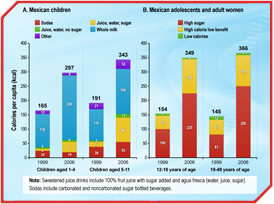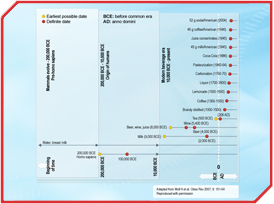
Key Points
- There is a marked increase across the globe in consumption of caloric beverages, particularly sugar-sweetened beverages (SSB's).
- For hundreds of thousands of year, man has consumed water alone (with only breast milk consumption for a few years of early life). Water is essential for life; we die in 2-4 days without water. For reasons unknown, we developed independent of our hunger mechanism, a separate thirst mechanism. Thus, when over the last 10-12,000 years we have developed caloric beverages we did not reduce food intake when we consumed them. However this became important and detrimental to global health only in the past 30-40 years.
- Globally, we have increased by hundreds of kcals per day our intake of SSB's in the past few decades. This unprecedented increase in intake of caloric beverages for which our body does not compensate by reducing food intake has been critical for global increased energy intake and subsequently added weight gain and central adiposity.
- Countries throughout the world are beginning to take actions to reduce intake of SSB's. Taxation, removal of vending machines from public facilities, promotion of water consumption, eliminating marketing of these products on TV and other media are some of the regulations and policies being implemented.
Overview
Over the past half century, there has been a rapid expansion in the consumption of caloric beverages, particularly those sweetened with some type of sugar. These dynamics have been driven partly by our preference for sweetened products and our desire for more options other than water and unsweetened tea and coffee and small amounts of milk and alcohol in our daily consumption patterns. At the same time, modern manufacturing, marketing and food distribution systems coupled with global subsidies of sugar have created very cheap alternatives to water, milk and alcohol that have captured very large segments of demand for beverages. Modern beverage companies have found ways to increase our total beverage intake.
Sweetness Preference
As I show in my book, sweetness preference has been with us for many thousands of years [1]. Furthermore, for hundreds of thousands of years, primates and mammals have showed a preference for sweet fruit. In the past half century, we have increasingly sweetened our food supply. Studies from places as diverse as the US, Mexico, Australia and South Africa have shown large increases in sugar intake, be it in the form of honey, a range of sugars from cane and beets, fruit juice concentrate, high-fructose corn syrup or the myriad other types of caloric sweeteners. The book provides the references used in my research on the global dimension of caloric sweeteners and the increases in all countries of sugar intake in the past several decades [1].
Beverages with Calories and Their Unique Biology
Our biology is also very much a product of our need for water intake in some form. We die in 2-4 days if we consume no water whereas we take months to die with no food consumption. Food was highly seasonal for much of our development. It was very important for us to consume food when available and at the same time we had to consume water daily. For reasons and mechanisms we do not fully understand, we do not reduce food intake when we consume water or any other beverage. This is linked in unclear ways back to our evolution. So when we drink a beverage-be it water, beer, wine, milk, fruit juice or some sugar-sweetened beverage-we do not reduce our food intake. This lack of compensation is hard to explain; however, it is critical in understanding how the recent global increase in caloric beverage consumption is affecting our net energy balance, abdominal obesity and metabolic conditions [2]. Figure 1 shows the history of our experience with beverages.
Increases in the Intake of Caloric Beverages
 [Click to enlarge]
[Click to enlarge]
In essence, what most nations in the world have seen is a remarkable increase in the consumption of caloric beverages. Some of this increase is healthy as with increased intake of milk. Unfortunately, much of it is whole milk, which contains excessive saturated fat. However, most nations have experienced a marked increase in sugary beverages. In Mexico, consumption of caloric beverages doubled from 1999-2006, with much of this intake in the form of juices with sugar added, whole milk or sugar-sweetened fruit and soft drinks as shown in Figure 2 [3]. I detail some of this history in my book [1].
Programmatic Actions
A few countries to date have created beverage guidance panels and begun to attempt to shift beverages back to healthier options. Mexico stands out for taking on this task in a most systematic way. Research in Mexico and the US (unpublished 20-year study of the effect of price changes on diet, weight dynamics and metabolic outcomes from CARDIA) shows that taxation of caloric beverages is linked with significant improvements in health [3, 4]. Program and policy actions across the globe are attempting in a range of ways to reduce consumption of sugary beverages. Nevertheless, there has been little rigorous evaluation of these options to date.
Taxation is one of the prime targets for caloric beverages. In Mexico and unpublished US research, we show that sugar-sweetened beverages are very sensitive to food prices. Applying an excise tax based either on the number of grams of sugar (any form of caloric sweetener in water) or the numbers of ounces would provide the clearest way to increase prices and significantly reduce intake of these sugary beverages. The Mexican panel wanted to couple a sugary beverage tax with one on the fat content of milk in order to enhance water and reduce fat milk intake.
Regulations are another important option. France banned all vending machines from its schools as did Singapore, among other countries. France, Sweden and a few other countries have banned sugary beverage advertisement from media to which children and teens are exposed.
There is strong evidence that any approach that changes the norms of society by banning advertisements of all sorts, keeping consumption of sugar-sweetened beverages out of schools and public places and providing inexpensive healthy options such as potable water, chilled in hot climates, is important. This option has worked for tobacco and can work for sugar-sweetened beverages.
Summary
Sugar-sweetened beverages in the area of cardiometabolic risk represent the low-hanging fruit that is closest to tobacco as an item with no benefits and huge health costs. Consumption of all caloric beverages, particularly those we would call sugar-sweetened beverages, have become a major component of the diet of most nations. Furthermore, due to the lack of dietary compensation when they are drunk, they have added considerably to the globe's problems of excess energy intake relative to energy expenditure. The major options for addressing this situation involve governmental actions. Education will not work, as the funding of the sugar and beverage sectors is in the tens of billions of dollars globally. Taxation, regulation in public facilities and regulation of media are the major options countries have other than completely banning these products.
References
- Popkin BM. The World Is Fat -- The Fads, Trends, Policies, and Products That Are Fattening The Human Race. New York: Avery-Penguin Group, 2008.
- Wolf A, Bray GA and Popkin BM. A short history of beverages and how our body treats them. Obes Rev 2008; 9: 151-64.
- Barquera S, Hernandez-Barrera L, Tolentino ML, et al. Energy intake from beverages is increasing among Mexican adolescents and adults. J Nutr 2008; 138: 2454-61.
- Rivera JA, Munoz-Hernandez O, Rosas-Peralta M, et al. [Beverage consumption for a healthy life: recommendations for the Mexican population]. Salud Publica Mex 2008; 50: 173 95.




